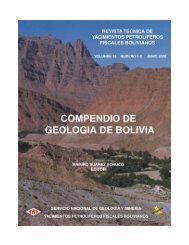Exploraciones por oro epitermal
You also want an ePaper? Increase the reach of your titles
YUMPU automatically turns print PDFs into web optimized ePapers that Google loves.
Corbett: Epithermal Gold For Explorationists<br />
McLaughlin, Champagne Pool). Some of the eruption breccia systems cap sheeted veins (e.g.,<br />
McLaughlin, Twin Hills), which extend into the breccia, while others cap mineralised fissure vein<br />
systems (e.g., Yamada). Sheeted and stockwork quartz veins my pass downwards into fissure veins<br />
(e.g., Golden Cross, Karangahaki). Fissure veins formed at depths up to 1 km are the main gold<br />
producers (e.g., Waihi, Hishikari, Sado, Vera Nancy, Pajingo) and these display well colloform<br />
banded quartz vein ores. Wavy crustiform banding is more commonly recognised in high level near<br />
sinter environments.<br />
Although cooling and traditional boiling models still hold for the deposition of gangue minerals<br />
(adularia, quartz pseudomorphing platy calcite and chalcedony), and some gold, mixing of rising<br />
pregnant fluids with oxygenated or collapsing acid sulphate (low pH) groundwaters is also favoured<br />
as a mechanism for the development of characteristic bonanza gold-silver grades (e.g., Hishikari,<br />
Corbett and Leach, 1998; Waihi, Brathwaite, 1999). Adularia-sericite vein systems are silver rich<br />
with Au:Ag ratios greater than 1:10 being common. Also recognised are: anomalous copper as<br />
chalcopyrite, mercury as cinnabar and antimony as stibnite.<br />
Wall rock alteration formed as halos to veins occurs as sericite (illite) grading to peripheral smectite<br />
clays with associated pyrite and chlorite, and this alteration grades to more marginal chloritecarbonate<br />
(propylitic) alteration. Low temperature acid waters developed by the condensation of<br />
volatiles in the vadose zone contribute towards the formation of surficial acid sulphate alteration<br />
comprising silica (chalcedony, opal), kaolin, and local alunite (Photo 29) and these acid sulphate<br />
waters are interpreted to collapse to deeper levels and so aid in mineral deposition (above).<br />
Structure and host rock competency are im<strong>por</strong>tant ore controls in adularia-sericite vein systems.<br />
Only brittle rocks which fracture well host veins and so in the C<strong>oro</strong>mandel Peninsular of New<br />
Zealand fissure veins are well developed in C<strong>oro</strong>mandel Group andesite and not rock units such as<br />
the overlying Whitianga Group felsic volcanics (e.g., Karangahake). Similarly, in Japan basement<br />
slates host the Hishikari and Konami deposits while Chitose and Sado occur in competent intrusive<br />
domes within less competent volcanic sequences. Veins are hosted within reactivated throughgoing<br />
regional structures (e.g., Vera Nancy, Karangahake, Asachinashoye), locally at structural dome<br />
intersections (e.g., Hishikari), or subsidiary more dilatant fractures (e.g., Waihi). High grade ore<br />
shoots often develop in dilational jogs or flexures in throughgoing veins where veins of greater<br />
thickness and higher gold grade develop (e.g., Vera Nancy, Simms, 2000), and the intersections of<br />
fault splays (e.g., Tolukuma). Bonanza ores may also develop at preferred sites of fluid quenching at<br />
rock competency changes (e.g., Hishikari). Floating clast breccias formed on the margins of many<br />
veins comprise host rock fragments incor<strong>por</strong>ated within the vein and rimmed by banded vein material<br />
(Photo 20).<br />
Adularia-sericite epithermal gold-silver mineralisation locally displays affinities with carbonate-base<br />
metal (e.g., Misima, Karangahake) and quartz-sulphide gold styles (e.g., Rawas, Chatree, Gulbadi at<br />
Tolukuma). Thus, particularly within magmatic arcs, there are some transitional relationships<br />
between intrusion-related and adularia-sericite epithermal gold-silver low sulphidation deposits.<br />
Exploration implications<br />
In suitable terrains many adularia-sericite epithermal gold-silver deposits were identified by gold<br />
panning and the identification of characteristic banded quartz in float (e.g., Tolukuma, Chatree),<br />
while in poorly prospected regions, sampling of outcropping quartz veins has led to the identification<br />
of new deposits (e.g., Pajingo, Cerro Vanguardia, Esquel). Recognition of the banded quartz early in<br />
exploration programs is clearly im<strong>por</strong>tant. In many cases continued drill testing has identified<br />
additional ore systems in the region (e.g., Pajingo to Vera Nancy, Golden Cross stockwork to Empire<br />
fissure vein, El Peñon vein system). Obscured vein systems may be identified by detailed analyses<br />
of illite crystallinity using PIMA or XRD (e.g., Golden Cross in Corbett and Leach, 1998), and CSAMT<br />
geophysics, a resistivity tool is attributed to have been im<strong>por</strong>tant in the discovery of the blind<br />
Hishikari vein system.<br />
As with other bonanza vein systems, care should be taken in the choice of drilling direction so as to<br />
intersect mineralised subsidiary dilatant veins at the best possible angle. It may be possible to<br />
Paper 2002-01, April 2002 15
















